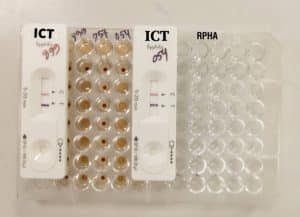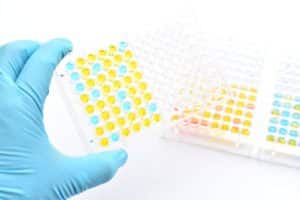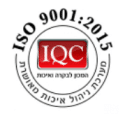What Are The Restrictions Of Elisa Tests? Unlocking The Enigma
Enzyme-linked immunosorbent assay (ELISA) is a powerful and widely used technique in the field of immunology and molecular biology. It’s instrumental in detecting the presence of specific proteins, antibodies, or antigens in a given sample.
ELISA has revolutionized medical diagnostics, research, and even food safety testing. However, like any other scientific method, it comes with its set of restrictions and limitations. In this comprehensive guide, we’ll delve into the various restrictions of ELISA tests and explore the challenges they pose in different applications.
The Basics of ELISA
Before we delve into its limitations, let’s briefly review how an ELISA test works. ELISA is a plate-based assay used to detect and quantify the presence of a target antigen (usually a protein) in a sample. It typically involves the use of antibodies – primary and secondary – and enzyme-labeled antibodies.
Here’s a simplified breakdown of the process:
Coating: The capture antibody, specific to the target antigen, is attached to a solid surface (usually a microplate). This forms the basis for antigen detection.
Blocking: Unbound sites on the solid surface are blocked to prevent non-specific binding.
Sample Addition: The sample containing the target antigen is added to the coated plate.
Primary Antibody: A primary antibody, specific to the antigen, is added, binding to the target protein.
Washing: The plate is washed to remove any unbound material.
Secondary Antibody: An enzyme-labeled secondary antibody is added. This antibody binds to the primary antibody.
Substrate Addition: A substrate specific to the enzyme is added, leading to a color change.
Measurement: The intensity of the color change is measured, which is directly proportional to the amount of antigen in the sample.
Restrictions Of Elisa Tests

Now that we have a basic understanding of ELISA, let’s explore the restrictions associated with this technique.
Limited Specificity
ELISA tests rely on the specificity of antibodies to accurately detect the target molecule. However, cross-reactivity can occur when antibodies mistakenly bind to non-target molecules that share structural similarities with the target antigen. This can lead to false positive results, limiting the reliability of ELISA in some cases.
Sensitivity Constraints
While ELISA is highly sensitive, it may not detect low concentrations of antigens or antibodies in some samples. This limitation can be a hurdle when dealing with samples that contain trace amounts of the target protein.
Labor and Time-Intensive
ELISA assays can be labor-intensive, requiring multiple steps and meticulous handling. They also demand relatively longer assay times compared to some other immunoassays, making them less suitable for situations that require rapid results.
Limited Multiplexing
ELISA is primarily a single-target assay. It’s challenging to simultaneously detect multiple antigens or antibodies in a single sample, which can be a limitation in cases where such multiplexing is necessary.
Dependency On High-Quality Antibodies
The accuracy of ELISA heavily relies on the quality and specificity of the antibodies used. Obtaining or producing high-quality primary and secondary antibodies can be challenging, and the use of suboptimal antibodies can lead to erroneous results.
ELISA Test Variants
There are several types of ELISA tests, including indirect ELISA, direct ELISA, sandwich ELISA, and competitive ELISA. Each variant has its unique set of applications and limitations. Understanding which type of ELISA to use for your specific purpose is crucial to obtaining accurate results.
Sensitivity And Specificity
While ELISA tests are highly sensitive and can detect even trace amounts of target antigens, they may sometimes produce false-positive or false-negative results. Factors such as the quality of primary and secondary antibodies, cross-reactivity, and the presence of interfering substances can affect the test’s specificity.
Antibody Selection
ELISA relies heavily on antibodies, both primary and secondary, for detection. Choosing the right antibodies is critical. Primary antibodies should have high affinity and specificity for the target protein, while secondary antibodies must be carefully selected to minimize cross-reactivity.
Unlabeled Primary Antibodies
ELISA tests often require the use of labeled primary antibodies for detection. However, this labeling process can introduce variability and affect the accuracy of results. Unlabeled primary antibodies, while avoiding this issue, may necessitate additional steps for detection.
ELISA Kits
Many researchers opt for ELISA kits for their convenience, but these kits can sometimes limit customization and optimization options. Researchers should be aware of the limitations of pre-packaged ELISA kits and consider whether a customized approach might yield better results.
Standardization

Ensuring consistency and reproducibility in ELISA tests can be challenging. Variations in reagents, equipment, and protocols can lead to discrepancies between experiments and laboratories. Standardization efforts are ongoing to address this limitation.
Cross-Reactivity
ELISA tests can sometimes exhibit cross-reactivity with related antigens. This can lead to false-positive results, especially when dealing with samples that contain multiple antigens with structural similarities.
Detection Limits
ELISA tests may have limitations in their ability to detect proteins at extremely low concentrations. Researchers should be aware of the specific detection limits of their chosen ELISA assay and consider alternative methods when higher sensitivity is required.
Time-Consuming
ELISA tests are not known for their speed. Depending on the type and complexity of the assay, ELISA can be a time-consuming process, which may not be suitable for situations where rapid results are needed.
Cost
The cost of ELISA tests can add up, especially when considering the purchase of antibodies, reagents, and specialized equipment. Researchers should weigh the costs against the benefits and consider budget constraints.
Quantitative Limitations
While ELISA is excellent for qualitative detection and semi-quantitative analysis, it may not provide precise quantitative data, especially when comparing samples across different experiments or laboratories.
Sample Volume Requirements
ELISA tests often require relatively large sample volumes, which can be a limitation when dealing with precious or limited samples.
Stability Of Enzyme-Labeling
Enzyme-labeled antibodies used in ELISA tests may degrade over time, affecting the accuracy of results. Proper storage and handling are crucial to maintain the stability of these reagents.
ELISA tests may not be suitable for all types of samples or antigens. Certain substances in the sample matrix, such as high concentrations of detergents or incompatible buffer components, can interfere with the assay.
Conclusion
While ELISA tests are invaluable tools in scientific research and diagnostics, it’s essential to be aware of their limitations. Understanding these restrictions and taking appropriate measures to address them can help researchers obtain more accurate and reliable results, ultimately advancing our understanding of biology, medicine, and various other fields where ELISA is applied.


